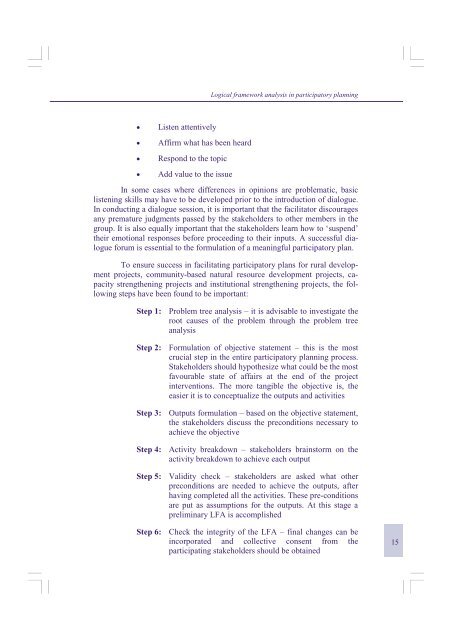Report of the Regional Workshop - Escap
Report of the Regional Workshop - Escap
Report of the Regional Workshop - Escap
You also want an ePaper? Increase the reach of your titles
YUMPU automatically turns print PDFs into web optimized ePapers that Google loves.
Logical framework analysis in participatory planning<br />
• Listen attentively<br />
• Affirm what has been heard<br />
• Respond to <strong>the</strong> topic<br />
• Add value to <strong>the</strong> issue<br />
In some cases where differences in opinions are problematic, basic<br />
listening skills may have to be developed prior to <strong>the</strong> introduction <strong>of</strong> dialogue.<br />
In conducting a dialogue session, it is important that <strong>the</strong> facilitator discourages<br />
any premature judgments passed by <strong>the</strong> stakeholders to o<strong>the</strong>r members in <strong>the</strong><br />
group. It is also equally important that <strong>the</strong> stakeholders learn how to ‘suspend’<br />
<strong>the</strong>ir emotional responses before proceeding to <strong>the</strong>ir inputs. A successful dialogue<br />
forum is essential to <strong>the</strong> formulation <strong>of</strong> a meaningful participatory plan.<br />
To ensure success in facilitating participatory plans for rural development<br />
projects, community-based natural resource development projects, capacity<br />
streng<strong>the</strong>ning projects and institutional streng<strong>the</strong>ning projects, <strong>the</strong> following<br />
steps have been found to be important:<br />
Step 1: Problem tree analysis – it is advisable to investigate <strong>the</strong><br />
root causes <strong>of</strong> <strong>the</strong> problem through <strong>the</strong> problem tree<br />
analysis<br />
Step 2: Formulation <strong>of</strong> objective statement – this is <strong>the</strong> most<br />
crucial step in <strong>the</strong> entire participatory planning process.<br />
Stakeholders should hypo<strong>the</strong>size what could be <strong>the</strong> most<br />
favourable state <strong>of</strong> affairs at <strong>the</strong> end <strong>of</strong> <strong>the</strong> project<br />
interventions. The more tangible <strong>the</strong> objective is, <strong>the</strong><br />
easier it is to conceptualize <strong>the</strong> outputs and activities<br />
Step 3: Outputs formulation – based on <strong>the</strong> objective statement,<br />
<strong>the</strong> stakeholders discuss <strong>the</strong> preconditions necessary to<br />
achieve <strong>the</strong> objective<br />
Step 4: Activity breakdown – stakeholders brainstorm on <strong>the</strong><br />
activity breakdown to achieve each output<br />
Step 5: Validity check – stakeholders are asked what o<strong>the</strong>r<br />
preconditions are needed to achieve <strong>the</strong> outputs, after<br />
having completed all <strong>the</strong> activities. These pre-conditions<br />
are put as assumptions for <strong>the</strong> outputs. At this stage a<br />
preliminary LFA is accomplished<br />
Step 6: Check <strong>the</strong> integrity <strong>of</strong> <strong>the</strong> LFA – final changes can be<br />
incorporated and collective consent from <strong>the</strong><br />
participating stakeholders should be obtained<br />
15

















